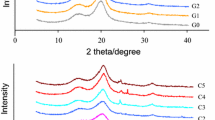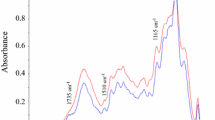Abstract
Ligno(hemi)cellulosics (L(h)Cs) as sugarcane bagasse and loblolly pine sawdust are currently being used to produce biofuels such as bioethanol and biobutanol through fermentation of free sugars that are often obtained enzymatically. However, this bioconversion requires a pretreatment to solubilize the hemicellulose fractions, thus facilitating the action of the cellulolytic enzymes. Instead of the main free monosaccharides used in these current models, the modulation of thermopressurized orthophosphoric acid as a pretreatment, in the ranges of 3–12 atm and pH 1.5–2.5, can produce nondigestible oligosaccharides (NDOS) such as xylo-oligosaccharides (XOS) because heteroxylan is present in both types of hardwood and softwood hemicelluloses. A comparative thin-layer chromatographic analysis of the hydrolytic products showed the best conditions for NDOS production to be 7 atm/water, pH 2.25 and 2.50, and 8.5 atm/water for both sources. Particular hydrolysates from 7 atm (171 °C) at pHs 2.25 and 2.50 both for cane bagasse and pine sawdust, with respective oligosaccharide contents of 57 and 59 %, once mixed in a proportion of 1:1 for each plant source, were used in vitro as carbon sources for Bifidobacterium or Lactobacillus. Once both bacteria attained the stationary phase of growth, an unforeseen feature emerged: the preference of B. animalis for bagasse hydrolysates and, conversely, the preference of L. casei for pine hydrolysates. Considering the fact that nutraceutical oligosaccharides from both hemicelluloses correspond to higher value-added byproducts, the technology using a much diluted thermopressurized orthophosphoric acid pretreatment becomes an attractive choice for L(h)Cs.






Similar content being viewed by others
References
Balcu I, Macarie CA, Segneanu A-E, Pop RO (2011) Combined microwave-acid pretreatment of the biomass. In: Shaukat DS (ed) Progress in biomass and bioenergy production. InTech, Rijeka, pp 223–239
Barrett E, Ross RP, O’Toole PW, Fitzgerald GF, Stanton C (2012) γ-Aminobutyric acid production by culturable bacteria from the human intestine. J Appl Microbiol 113(2):411–417. doi:10.1111/j.1365-2672.2012.05344.x
Bornet FRJ, Meflash K, Menanteau J (2002) Enhancement of gut immune functions by short-chain fructooligosaccharides and reduction of colon cancer risk. Biosci Microflora 21(1):55–62
Bouveng HO, Lindberg B (1960) Methods in structural polysaccharide chemistry. Adv Carbohydr Chem 15:53–89
Campbell JM, Fahey GC Jr, Wolf BW (1997) Selected indigestible oligosaccharides affect large bowel mass, cecal and fecal short-chain fatty acids, pH and microflora in rats. J Nutr 127(1):130–136
Canilha L, Kumar Chandel A, dos Santos Milessi TS, Fernandes Antunes FA, da Costa Freitas WL, das Graças Almeida Felipe M, da Silva SS (2012) Bioconversion of sugarcane biomass into ethanol: an overview about composition, pretreatment methods, detoxification of hydrolysates, enzymatic saccharification, and ethanol fermentation. J Biomed Biotechnol 2012:989572
Carvalho AFA, de Oilva Neto P, da Silva DF, Pastore GM (2013) Xylo-oligosaccharides from lignocellulosic materials: chemical structure, health benefits and production by chemical and enzymatic hydrolysis. Food Res Int 51(1):75–85. doi:10.1016/j.foodres.2012.11.021
Christie WW (2011) Thin-layer chromatography of lipids. The AOCS lipid library. http://lipidlibrary.aocs.org/topics/tlc/index.htm. Accessed 15 Jan 2013
DuBois M, Gilles KA, Hamilton JK, Rebers PA, Smith F (1956) Colorimetric method for determination of sugars and related substances. Anal Chem 28(3):350–356. doi:10.1021/ac60111a017
Fontana JD, Correa JBC, Duarte JH (1984) Aqueous phosphoric acid hydrolysis of hemicelluloses from sugarcane and sorghum bagasses. Biotechnol Bioeng Symp 14:175–186
Fontana JD, Grzybowski A, Tiboni M, Passos M (2011) Fructo-oligosaccharides production from inulin through partial citric or phosphoric acid hydrolyses. J Med Food 14:1425–1430
Fontana JD, Mitchell DA, Molina OE, Gaitan A, Bonfim TMB, Adelmann J, Grzybowski A, Passos M (2008) Starch depolymerization with diluted phosphoric acid and application of the hydrolysate in astaxanthin fermentation. Food Technol Biotechnol 46(3):305–310
Harmsen PFH, Huijgen WJJ, Bermúdez-López LM, Bakker RRC (2010) Literature review of physical and chemical pretreatment process for lignocellulosic biomass. Food and Biobased Research, Wageningen
Hsu C-K, Liao J-W, Chung Y-C, Hsieh C-P, Chan Y-C (2004) Xylooligosaccharides and fructooligosaccharides affect the intestinal microbiota and precancerous colonic lesion development in rats. J Nutr 134(6):1523–1528
Hugenholtz F, Mullaney JA, Kleerebezem M, Smidt H, Rosendale DI (2013) Modulation of the microbial fermentation in the gut by fermentable carbohydrates. Bioact Carbohyd Diet Fibre 2(2):133–142. doi:10.1016/j.bcdf.2013.09.008
Kumar R, Singh S, Singh O (2008) Bioconversion of lignocellulosic biomass: biochemical and molecular perspectives. J Ind Microbiol Biotechnol 35(5):377–391. doi:10.1007/s10295-008-0327-8
Lynd LR, Weimer PJ, van Zyl WH, Pretorius IS (2002) Microbial cellulose utilization: fundamentals and biotechnology. Microbiol Mol Biol R 66(3):506–577. doi:10.1128/MMBR.66.3.506-577.2002
Miller GL (1959) Use of dinitrosalicylic acid reagent for determination of reducing sugar. Anal Chem 31(3):426–428
Nugent SG, Kumar D, Rampton DS, Evans DF (2001) Intestinal luminal pH in inflammatory bowel disease: possible determinants and implications for therapy with aminosalicylates and other drugs. Gut 48:571–577. doi:10.1136/gut.48.4.571
O’Hara IM (2011) Cellulosic ethanol from sugarcane bagasse in Australia: exploring industry feasibility through systems analysis, techno-economic assessment and pilot plant development. Queensland University of Technology, Brisbane
Plethico (2010) Global nutraceuticals market to cross US$187 billion by 2010, according to a new report by Global Industry Analysts, Inc. http://www.plethico.com/addons/Global%20Nutraceuticals%20Market.pdf. Accessed 17 Apr 2013
Price NPJ, Hartman TM, Faber TA, Vermillion KE, Fahey GC (2011) Galactoglucomannan oligosaccharides (GGMO) from a molasses byproduct of pine (Pinus taeda) fiberboard production. J Agric Food Chem 59(5):1854–1861. doi:10.1021/jf1037097
Rudolf A, Baudel H, Zacchi G, Hahn-Hägerdal B, Lidén G (2008) Simultaneous saccharification and fermentation of steam-pretreated bagasse using Saccharomyces cerevisiae TMB3400 and Pichia stipitis CBS6054. Biotechnol Bioeng 99(4):783–790
Scott KP, Gratz SW, Sheridan PO, Flint HJ, Duncan SH (2013) The influence of diet on the gut microbiota. Pharmacol Res 69(1):52–60. doi:10.1016/j.phrs.2012.10.020
Sweet MS, Winandy JE (1999) Influence of degree of polymerization of cellulose and hemicellulose on strength of treated southern pine. Holzforschung 53:311–317
Wu GD, Bushmanc FD, Lewis JD (2013) Diet, the human gut microbiota, and IBD. Anaerobe 24(0):117. doi:10.1016/j.anaerobe.2013.03.011
Zhang B, Shahbazi A, Wang L, Diallo O, Whitmore A (2011) Hot-water pretreatment of cattails for extraction of cellulose. J Ind Microbiol Biotechnol 38(7):819–824. doi:10.1007/s10295-010-0847-x
Acknowledgments
The authors would like to thank the National Council for Scientific and Technological Development (CNPq), the Coordination for the Improvement of Higher Education Personnel (CAPES), and the Araucaria Foundation from SETI-PR.
Author information
Authors and Affiliations
Corresponding author
Rights and permissions
About this article
Cite this article
Tiboni, M., Grzybowski, A., Baldo, G.R. et al. Thermopressurized diluted phosphoric acid pretreatment of ligno(hemi)cellulose to make free sugars and nutraceutical oligosaccharides. J Ind Microbiol Biotechnol 41, 957–964 (2014). https://doi.org/10.1007/s10295-014-1426-3
Received:
Accepted:
Published:
Issue Date:
DOI: https://doi.org/10.1007/s10295-014-1426-3




